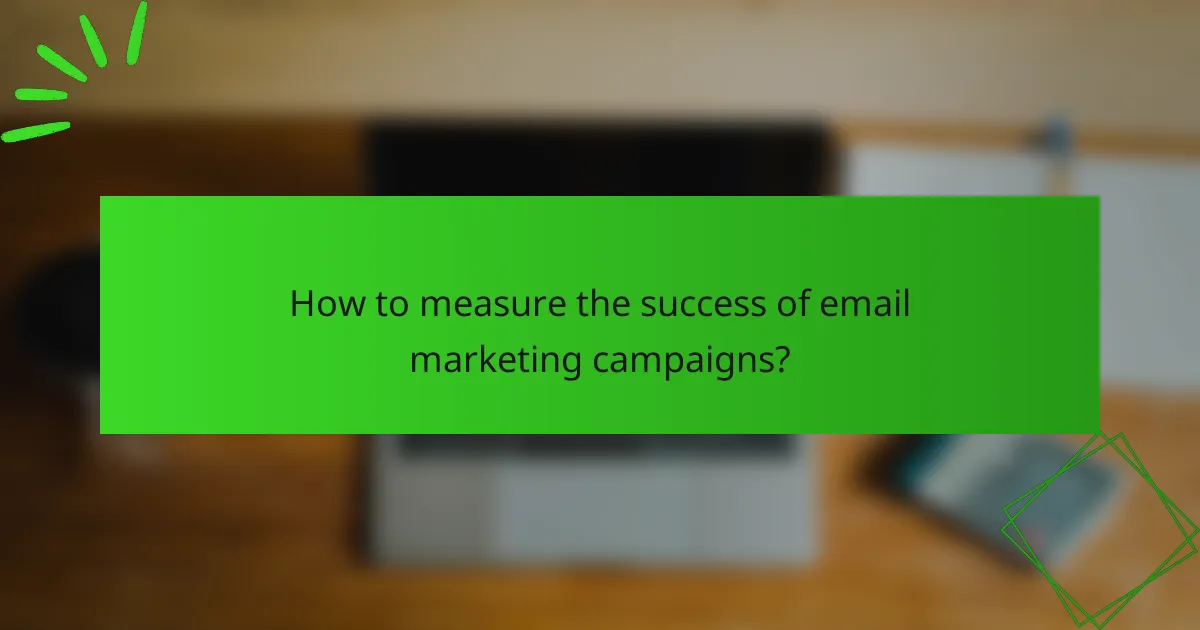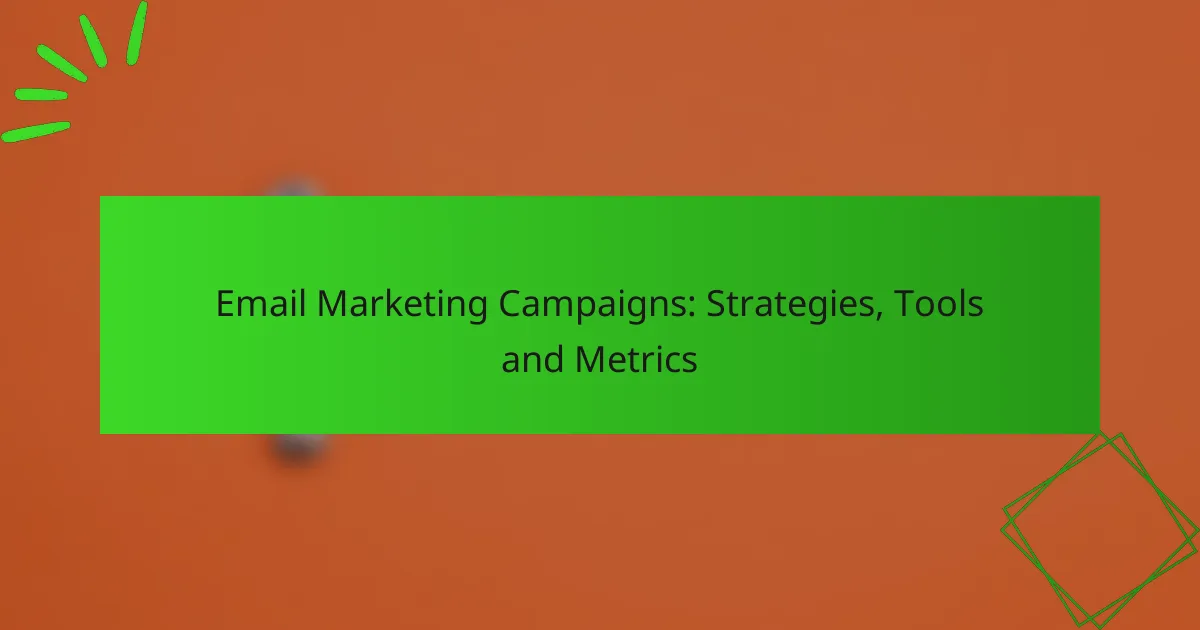Email marketing campaigns are essential for engaging customers and driving results, especially for Canadian businesses. By implementing strategies such as segmentation, personalization, and automation, companies can create tailored content that resonates with their audience. Additionally, leveraging the right tools and measuring key metrics allows marketers to optimize their efforts and enhance overall campaign effectiveness.

What are effective email marketing strategies for Canadian businesses?
Effective email marketing strategies for Canadian businesses focus on engaging customers through tailored content and efficient processes. By utilizing segmentation, personalization, automation, A/B testing, and mobile optimization, businesses can enhance their email campaigns and drive better results.
Segmentation for targeted messaging
Segmentation involves dividing your email list into smaller groups based on specific criteria such as demographics, purchase history, or engagement levels. This targeted messaging allows businesses to send relevant content that resonates with each group, increasing the likelihood of engagement.
For example, a Canadian retailer might segment their list by location to promote region-specific products or offers. This approach can lead to higher open and click-through rates, as recipients receive messages that are more aligned with their interests.
Personalization to increase engagement
Personalization goes beyond using a recipient’s name in the email. It includes tailoring content based on user behavior, preferences, and past interactions. By providing personalized recommendations or exclusive offers, businesses can create a more engaging experience for their audience.
For instance, an e-commerce site could send personalized product suggestions based on previous purchases, which can significantly boost conversion rates. Using data analytics tools can help identify patterns and preferences for more effective personalization.
Automated workflows for efficiency
Automated workflows streamline email marketing processes by sending targeted messages based on specific triggers, such as user actions or dates. This efficiency allows businesses to maintain consistent communication without manual effort.
For example, a welcome series for new subscribers can be automated to introduce them to the brand over a few days. This not only saves time but also ensures that new customers receive timely and relevant information that nurtures their interest.
A/B testing for optimization
A/B testing involves sending two variations of an email to different segments of your audience to determine which performs better. This method helps identify the most effective subject lines, content, and layouts, leading to improved campaign performance.
When conducting A/B tests, focus on one element at a time, such as the call-to-action button color or email layout. Analyzing the results can provide insights that inform future campaigns and enhance overall engagement.
Mobile optimization for accessibility
With a significant portion of emails opened on mobile devices, optimizing email design for mobile accessibility is crucial. This includes using responsive design, concise content, and easily clickable buttons to enhance the user experience.
Ensure that emails are visually appealing and functional on smaller screens by testing them across various devices. A mobile-friendly approach can lead to higher engagement rates, as users are more likely to interact with content that is easy to navigate on their smartphones.

Which tools enhance email marketing campaigns?
Several tools can significantly enhance email marketing campaigns by improving design, integration, automation, and promotion. Choosing the right tool depends on your specific needs, such as ease of use, customer relationship management (CRM) capabilities, or advanced automation features.
Mailchimp for user-friendly design
Mailchimp is known for its intuitive interface, making it easy for users to create visually appealing emails without extensive design skills. The platform offers a variety of customizable templates and a drag-and-drop editor, allowing marketers to quickly build campaigns that align with their brand.
Additionally, Mailchimp provides analytics to track engagement metrics, helping users refine their design strategies over time. For small businesses or beginners, Mailchimp’s free tier offers essential features, making it a practical starting point.
HubSpot for comprehensive CRM integration
HubSpot excels in integrating email marketing with its comprehensive CRM system, allowing for seamless management of customer relationships. This integration enables personalized email campaigns based on user behavior and demographic data, enhancing engagement rates.
With HubSpot, users can automate workflows, segment their audience, and analyze campaign performance all in one platform. This is particularly beneficial for businesses looking to align their marketing and sales efforts effectively.
Constant Contact for event promotion
Constant Contact is particularly effective for promoting events, offering features tailored to managing registrations and invitations. Users can create event-specific emails, track RSVPs, and even integrate payment processing for ticket sales.
The platform also provides social media sharing options, allowing users to extend their event reach. For organizations frequently hosting events, Constant Contact’s tools simplify the promotion process and enhance attendee engagement.
ActiveCampaign for advanced automation
ActiveCampaign stands out for its advanced automation capabilities, enabling users to create complex email workflows based on user interactions. This allows for highly targeted campaigns that can respond to customer behavior in real-time.
Users can set up triggers for various actions, such as sending follow-up emails after a purchase or re-engaging inactive subscribers. This level of automation can significantly improve conversion rates and customer retention, making it a valuable tool for businesses focused on growth.

How to measure the success of email marketing campaigns?
Measuring the success of email marketing campaigns involves tracking key metrics that reflect engagement, effectiveness, and overall return on investment (ROI). By analyzing these metrics, marketers can make informed decisions to optimize future campaigns.
Open rates for engagement tracking
Open rates indicate the percentage of recipients who opened an email, serving as a primary measure of engagement. A typical open rate can range from 15% to 25%, depending on the industry and audience. To improve open rates, consider crafting compelling subject lines and sending emails at optimal times.
Monitoring open rates helps identify trends in audience interest and can guide adjustments in content and targeting strategies. A/B testing different subject lines can also provide insights into what resonates best with your audience.
Click-through rates for content effectiveness
Click-through rates (CTR) measure the percentage of recipients who clicked on links within the email, reflecting the effectiveness of your content. A good CTR generally falls between 2% and 5%, but this can vary by sector. To enhance CTR, ensure that your email content is relevant and includes clear calls to action.
Analyzing CTR helps determine which types of content engage your audience most effectively. Consider segmenting your audience to tailor messages and improve click rates further.
Conversion rates for ROI assessment
Conversion rates represent the percentage of recipients who completed a desired action, such as making a purchase or signing up for a webinar. This metric is crucial for assessing the ROI of your email marketing efforts. A typical conversion rate might range from 1% to 3% for many industries.
To boost conversion rates, ensure that your emails provide value and include persuasive elements such as testimonials or limited-time offers. Tracking conversions allows you to evaluate the financial effectiveness of your campaigns and adjust strategies accordingly.
Unsubscribe rates for list health
Unsubscribe rates indicate the percentage of recipients who opted out of your email list, providing insight into list health and content relevance. A low unsubscribe rate, typically below 1%, suggests that your audience finds value in your emails. High rates may signal a need for content reevaluation.
To maintain a healthy list, regularly review unsubscribe feedback and adjust your email frequency and content accordingly. Offering preferences for email types can also help reduce unsubscribes and keep your audience engaged.

What are the prerequisites for a successful email marketing campaign?
Successful email marketing campaigns require a well-defined strategy, a targeted audience, and measurable objectives. These elements ensure that your messages reach the right people and achieve desired outcomes.
Building a quality email list
Creating a quality email list is foundational for effective email marketing. Focus on gathering contacts who have opted in to receive communications, as this increases engagement and reduces the likelihood of spam complaints.
Utilize various methods to build your list, such as offering incentives like discounts or exclusive content. Regularly clean your list by removing inactive subscribers to maintain high deliverability rates.
Establishing clear campaign goals
Clear campaign goals guide your email marketing efforts and help measure success. Common objectives include increasing sales, boosting website traffic, or enhancing brand awareness.
When setting goals, use the SMART criteria—specific, measurable, achievable, relevant, and time-bound. For example, aim to increase your open rate by a certain percentage within a defined timeframe, which provides a clear target to work towards.










